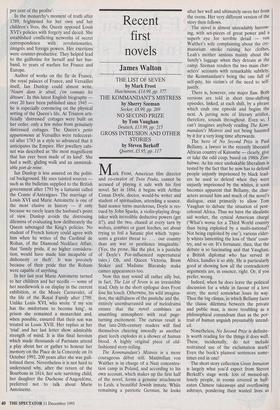The Austrian queen
Philip Mansel
MARIE ANTOINE 11'E, by Ian Dunlop Sinclair-Stevenson, f20, pp. 410 The ceremonial hall in the Hofburg in Innsbruck contains one of the finest sets of dynastic portraits in Europe. The walls are covered with massive portraits of the Empress Maria Theresa, her husband, the Holy Roman Emperor Francis I, and most of their 14 children. Above the children are diminutive portraits of their spouses: even the King of France, Louis XVI, is dwarfed by his wife Marie Antoinette. The key to Marie Antoinette was her family's inten- tion that she should overshadow her hus- band in reality as well as on the palace walls. She was born to be an instrument of Austrian ambition.
Nationality was far less exclusive than today, but loyalty to your adopted country or monarchy was expected. Yet in the reign of Louis XVI the Queen of France tried to influence the French government to support Austrian ends. Helped by the propaganda emitted by the Austrian ambassador Mercy-Argenteau, a monster of mendacity, Marie Antoinette's influence was widely assumed to be all-powerful. As far away as Istanbul, the Grand Vizier delayed receiving the ambassador of France because he was thought to be the creature of Austria.
An English agent quoted by Ian Dunlop admitted that
the extent of the influence of the Queen's party goes no farther than to the disposal of certain places and pensions with- out interfering in the great line of public business and particularly that of foreign affairs.
Yet even he thought that the minister Calonne was her creature. The popular adulation with which she had been received when she arrived in France in 1770 turned to silent indifference, then psychotic hatred. There were so many hostile pam- phlets that the Prince de Ligne told her he was convinced 'that Your Majesty takes 50
per cent of the profits'.
In the monarchy's moment of truth after 1789, frightened for her own and her children's lives, the Queen opposed Louis XVI's policies with forgery and deceit. She established conflicting networks of secret correspondence with revolutionaries, émigrés and foreign powers. Her exertions were counter-productive. They helped lead to the guillotine for herself and her hus- band, to years of warfare for France and Europe.
Author of works on the Ile de France, the royal palaces of France, and Versailles itself, Ian Dunlop could almost write, Wouni dans le serail, fen connais les detours'. In this latest English biography over 20 have been published since 1945 he is especially convincing on the physical setting of the Queen's life. At Trianon arti- ficially 'distressed' cottages were built on her order, only a few miles from genuinely distressed cottages. The Queen's petits appartements at Versailles were redecorat- ed after 1783 in a style so advanced that it anticipates the Empire. Her jewellery cabi- net was described as 'the most magnificent that has ever been made of its kind'. She had a swift, gliding walk and an unmistak- able port de reine.
Ian Dunlop is less assured on the politi- cal background. He uses tainted sources such as the bulletins supplied to the British government after 1793 by a fantasist called the Comte d'Antraigues. The marriage of Louis XVI and Marie Antoinette is one of the most elusive in history — if only because we rarely learn the husband's point of view. Dunlop avoids the distressing dilemma of evaluating how deliberately the Queen sabotaged the King's policies. No student of French history could agree with him when he writes of the Cardinal de Rohan, of the Diamond Necklace Affair, that 'family pride, if no higher considera- tion, would have made him incapable of dishonesty or theft'. It was precisely because of their pride that the Rohans were capable of anything.
In her last year Marie Antoinette turned to her children and her needle — some of her needlework is on display in the current exhibition, at the Musee Carnavalet, of the life of the Royal Family after 1789. Unlike Louis XVI, who wrote 'if my son has the misfortune to become king', in prison she remained a monarchist and, when possible, ensured that their son was treated as Louis XVII. Her replies at her `trial' and her last letter show admirable strength of mind. It is this final heroism which made thousands of Parisians attend a play about her or gather to honour her memory on the Place de la Concorde on 16 October 1993, 200 years after she was guil- lotined there. Nevertheless it is not hard to understand why, after the return of the Bourbons in 1814, her sole surviving child, her daughter the Duchesse d'Angouleme, preferred not to talk about Marie Antoinette.



































































 Previous page
Previous page